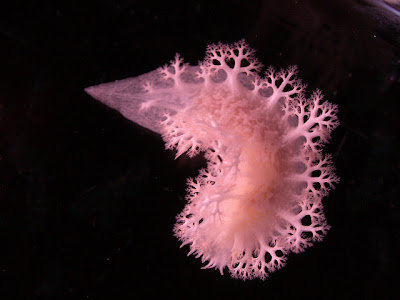This incredibly intimate video offers an extreme close-up of the life atop a thorny oyster (Spondylus americanus)—an ecosystem within the ecosystem of a coral reef. The rim of the thorny oyster (partially visible at the bottom right of the video frame) is lined with dozens of eyes that detect changes in light indicating the approach of a potential predator. When movement is detected, the oyster snaps its shells together, sealing the animal inside with powerful adductor muscles
Amazingly, you can watch x-raylike through the nudibranch's translucent tissues as it swallows its prey, a hydroid. Read on to learn how the nudibranch does so much more with its meal than simply digest it.
From the Morphologic Blog of the Morphologic Studio, describing the diverse community of animals and plants colonizing the upper shell of the oyster, as seen in the video:
Amazingly, you can watch x-raylike through the nudibranch's translucent tissues as it swallows its prey, a hydroid. Read on to learn how the nudibranch does so much more with its meal than simply digest it.
From the Morphologic Blog of the Morphologic Studio, describing the diverse community of animals and plants colonizing the upper shell of the oyster, as seen in the video:
Towards the left of the frame is a small colony of flower-like animals known as hydroids. Hydroids are most closely related to jellyfish, but instead remain attached to the reef their whole lives (unlike a jellyfish). But, like the jellyfish, hydroids can pack a powerful stinging punch. The brown, daisy-like creatures seen growing here on the oysters’s back are one such type of hydroid, Myrionema amboinense. This hydroid species derives its brown coloration from the symbiotic zooxanthellae (dinoflagellate ‘algae’) stored in its tissues. The ability to gain nutrition from both prey capture and photosynthesis, allows these hydroids to grow and colonize quickly. The sting from these hydroids is considerably more powerful than that of most corals. The gray, lumpy knobs on the back of the oyster shell are zoanthid polyps, close cousins of the sea anemones. However, these zoanthids are no match against the powerful sting of the hydroids. The zoanthids have all but acknowledged defeat by the encroaching stingers by simply closing up; effectively handing over control of the oyster shell to the hydroids.
The tiny, but powerful hydroids have one mortal enemy… the lynx nudibranch Phidiana lynceus. The lynx nudibranch only dines upon hydroids, and is especially fond of Myrionema amboinense. In the video we observe the lynx nudibranch on the hunt. With sight limited to only the detection of light and dark, the nudibranch relies on touch and ’smell’ to detect its surroundings. By sweeping its two oral tentacles open wide as it moves, it maximizes its likelihood of coming into contact with a hydroid. When they touch, the nudibranch reacts abruptly from the hydroid’s sting. Once the hydroid has been detected, the nudibranch is challenged with the task of eating it. The video shows how carefully the nudibranch goes about positioning itself in order minimize the sting of the hydroid’s defensive nematocysts. Once the hydroid polyp is successfully engulfed, the nudibranch tears off the soft tentacles in a few swift movements and swallows them. If you look carefully, you can see through the nudibranch’s translucent tissue and see the swallowed mass pass through the nudibranch’s esophagus. The nudibranch’s patient and careful consumption of the stinging hydroid suggests that even it is not immune from the spicy burn of the ingested nematocysts. Amazingly, the lynx nudibranch separates both the photosynthetic zooxanthellae and stinging nematocysts from the hydroid before digesting the rest. The zooxanthellae and nematocysts are then transferred into the flap-like tassles, known as cerata, that adorn the creature’s back. Consequently, the nudibranch reaps the sweet, photosynthetic rewards of symbiotic zooxanthellae (i.e. solar power) in the same way that the hydroid does. Furthermore, the incorporated nematocysts act as a powerful defense mechanism against potential predators.
Nudibranchs are named for their exterenal flowery gills (Latin nudus: naked; Greek brankhia: gills). Here's a gallery of nudibranch beauties with a variety of colorful gills.














0 comments:
Post a Comment